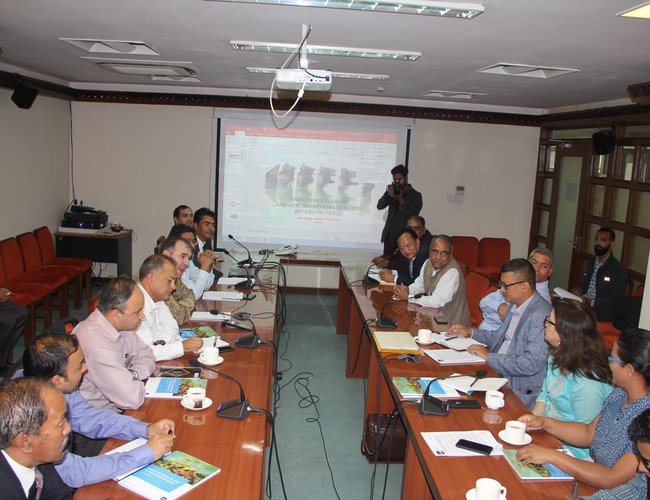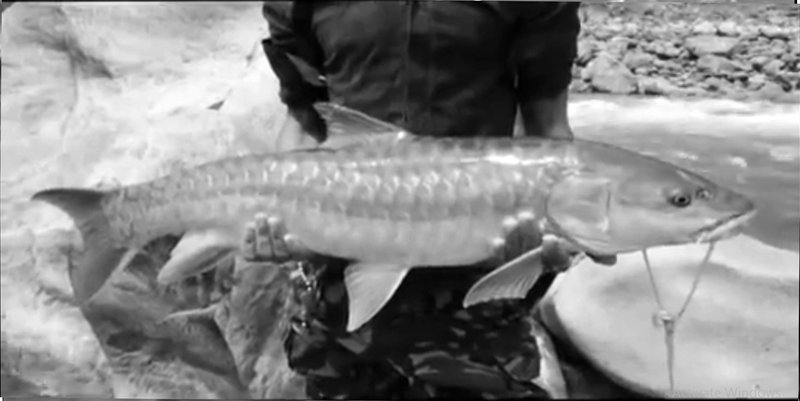
Mai Khola of Ilam and Modi Khola of Parbat, Marsyangdi and Daraudi of Lamjung are examples of how the construction of casket hydropower dams are destroying aquatic life and fisheries.
With virtually no fish ladders and other such safeguards, fishes are disappearing from many rivers. As Nepal’s demand for energy is growing, the exploitation of water resources for energy generation is natural but, on its flip side, aquatic life is coming under threat.
However, there is also the need to give equal weight to the conservation of ecosystem of the river, which is the lifeline of aquatic culture and lifeline of human livelihood. During the process of Environmental Impact Assessment, promoters have agreed to give due attention to these aspects.
The reality is different in the rivers. With the construction of dams, hydropower uses all the water in generating power, not discharging even a drop.
These are not the only examples. Except for a dam like Babai Irrigation Project of Bardia district, starting from Kosi to Gandak, all the dams constructed during the last six decades are unfriendly to aquatic life and fishes.
As the numbers of dam have continued to increase in the recent years, they are virtually wiping out the fishes of the rivers. Despite the mandatory provision to include fish ladders and fish friendly system, promoters including Nepal government pay a little attention on it.
As Nepal has been moving with a grand target to generate 10,000 MW of hydropower by 10 years for domestic and export purposes and planning to build more dams to irrigate land, Nepal's river eco-system and fisheries are great threat for their existence.
Dilemma In Priority
If hydropower generation is the priority, the government has to choose the rivers with intense study about the fisheries and eco-system. Based on the nature and kind of fishes, the government has to allow promoters to dam the rivers.
The government should come with the priority, keeping in mind the needs to preserve eco-system as well. Nepal needs energy and water for irrigation as well as to protect the endangered fish species as well.
The dam of Babai shows how to manage the fishes and water for irrigation purposes. With functional fish ladders, Babai is conserving fishes and providing water for irrigation.
Kali Gandaki Hydropower has a well developed fish hatchery. However, it is not properly functional due to lack of budget. In promoting the fisheries, Kulekhani has been one project helping protect fisheries.
Nepal needs to exploit the water resources to meet the demand of energy and water for irrigation but there is also the need to give a proper attention to aquatic life and eco-system of the rivers.
Although Nepal's Environmental Impact Assessment has given clear guidelines to make the necessary arrangements to protect the fishes in the phase of construction of dam for hydropower projects.
Nobody follows the guidelines. During the EIA process, promoters have agreed to build fish ladders, release minimum level of waters and construct hatchery. However, nobody abides by the commitments.
Recent Study
According to a recent study, hydropower projects build the dam with a fish ladder just to show that they have it. Those who are obliged to build fish hatchery have been the least concerned about the fishes.
Given the present state, ADB's study report prepared by Deepak Bahadur Singh, Senior Environment Officer, Nepal Resident Mission, ADB, and Dr. Deep Bahadur Swar, Consultant Fisheries Expert, is highly relevant.
ADB’s Country Director for Nepal Mukhtor Khamudkhanov expressed the hope that a study report on the impact of dams and fish in the rivers of Nepal will open the door for more discussion and extensive research on this important topic.
Addressing a dissemination seminar on the study of Impact of Dams on Fish in the Rivers of Nepal ADB's Country Director Mukhtor Khamudkhano said that the study will contribute to save endangered species of the Himalayan rivers.
“A broader understanding of the importance of a healthy fish habitat to maintaining balance in the ecosystem and food chain and generating economic and social benefits from fisheries will go a long way in promoting environmentally sustainable development,” said Mukhtor Khamudkhanov, ADB’s Country Director for Nepal.
"Special measures are needed in hydro and irrigation projects in Nepal to arrest rapidly declining fish stocks in the country’s rivers, according to a new study from the Asian Development Bank (ADB)."
The new study from the Asian Development Bank (ADB) assessed the impact of projects including the construction of dams on aquatic biodiversity and came up with several recommendations to save fish population in the rivers of Nepal.
“Early findings of this study suggest that the fish population in Nepal’s river basins with dams are in sharp decline,” said Deepak Bahadur Singh, ADB’s Senior Environment Officer and co-author of the study.
“Some technical considerations while building dams or other such projects can go a long way in saving the fish population. Providing a fish ladder, building a fish passage, and a fish bypass channel, are some examples.”
In addition, breeding fish in hatcheries and annually releasing them upstream and downstream of the dam to maintain their populations could also be effective, says the study. The study also recommends a “fish screening framework” for identifying the scale of impact on fish by a development project and adopting typical mitigation measures.
The study assessed the operation of selected hydropower and irrigation systems with dams to divert water. The systems included the Kali Gandaki, Marsyangdi, Middle Marsyangdi, Kulekhani, Khimti, and Trishuli hydropower projects, and the Babai irrigation project. The study also reviewed international good practices, particularly in South Asia, on mitigating the impacts on fish while constructing projects with dams on rivers.
The study suggests that effective regional cooperation between Bangladesh, India, and Nepal could help conserve the valuable and threatened aquatic fauna by ensuring the animals’ trans-boundary movements for feeding and reproduction. A few tributaries in each major river basin could also be declared aquatic life protection areas, or even a fisheries national park.
The study concludes that a strong legal provision and a dedicated government agency to enforce the rules and regulations are crucial in protecting fish habitat in the country.

Fish Diversity
As the rivers of Nepal are a significant habitat of many resident and short to long-distance migratory fish species, dams create barriers that restrict movement and many cases threaten species survival.
Along with biodiversity, Nepal is also known for its diversity in fishes. Acting Executive Director of Nepal Agriculture Research Center Dr. Tek Bahadur Gurung said the report prepared by ADB's team is highly important and worthy to raise the awareness about the importance of aquatic animals for preserving the river environment.
He thanked author duo Deepak Bahadur Singh and Deep Bahadur Swar for bringing a very detailed report on the fisheries in Nepal and the damage caused by the construction of hydropower and irrigation dams.
According to the study, IUCN Red List for fish and fauna in Nepal includes 21 rare and endangered fish species. At a time when Nepal has been in the process of building more hydropower projects by involving public and private sectors, these endangered species will be extinct if serious and proper safeguards and measurements are not considered for fish during the construction of dams.
As ADB is a leading multilateral development partner of energy sector, the commitment shown by the bank will help balance development between fish species and hydropower projects.
"By virtue of being the second richest country in the world in water resources, export-oriented hydropower generation and food security through irrigated agriculture are two important catalysts that can steer Nepal toward prosperity. The country has initiated planning and construction of hydropower projects that aim to generate 5,000 megawatts of electricity within the next 5 years," said Mukhtor Khamudkhanov, ADB’s Country Director for Nepal.
"Major irrigation systems with inter-basin water transfer are being implemented to improve commercial agriculture. The majority of these projects need dams or barrages across rivers for water diversion. Dams are important to harness water's potential to support economic growth but also pose environmental concerns, such as damage to aquatic habitats and blockage to the movement of endemic and migratory fish in river basins. "
"The water bodies of Nepal represent unique ecosystems that are highly rich in fish fauna. All rivers of Nepal drain to the Ganges in India, hence they are interconnected. Many short- and long-distance migratory fish species travel along these river basins during their life cycle," said the report. "Some of them are believed to spawn in the Bay of Bengal and travel all the way back to the Ganges and reach the rivers of Nepal to complete their reproductive cycle. However, their movement is becoming seriously affected by the increasing number of dams along their migratory routes."
Dams block fish movement and create reservoirs in a free-flowing river, which deteriorates water quality, alter the existing ecosystem, and damage spawning grounds of native fish species. Early findings of this study suggest that the fish populations in Nepalese river basins with dams are in sharp decline. The impact on aquatic biodiversity generally goes unnoticed when sufficient legal provisions and a dedicated government agency to enforce them are lacking. Gaps in research on fish in river basins of the country and limitations to mapping their routes have made it difficult for decision-makers to locate dams at suitable places to avoid blockage of fish movement in interconnected river basins
Multiple dams have been constructed in the rivers of Nepal for diverting water for power generation and irrigation. The rate of damming rivers is expected to increase rapidly in the future to generate more hydropower and construct major irrigation systems. The rivers flowing through the varied ecological realms of the country host many indigenous rare and endangered fish species and other aquatic organisms, creating unique river ecosystems.
However, the aquatic fauna’s migratory behavior, routes, and range of movement for feeding and reproduction are neither properly studied nor understood. In the absence of this information, it is difficult to identify locations for dams on the rivers without significantly obstructing the animals’ migratory route. The past and ongoing damming of rivers have had huge environmental costs with serious and irreversible impacts, including the rapid decline in the population of many fish species. The Asian Development Bank conducted a rapid study and assessed the potential impacts of damming of rivers in Nepal on fish biodiversity.
The study reviewed the result of mitigation and compensatory measures for the protection of fish that were adopted in past projects and the recommended measures that proved to be successful. A fish biodiversity screening checklist was prepared to screen future development projects for impacts on fish biodiversity and to design appropriate mitigation measures, depending on the significance of the impact. The study also aimed to prepare a basis for future research on fish biodiversity in the rivers of Nepal to better understand the impacts and formulate appropriate mitigation measures.

Fisheries in Nepal are significant sources of food, nutrition, and recreation; this is a traditional way of sustaining life and livelihood. Recreational angling is rapidly picking up, with the presence of highly sought-after game fish species like the Tor putitora (Golden Mahseer) and Bagarius yarrelli (Goonch). A healthy fish habitat is vital to maintaining balance in the ecosystem and food chain and generating economic and social benefits from fisheries.
This requires a comprehensive approach for fisheries management, including conservation of existing fish habitats, restoration, and sustainable commercial use. Fish habitats can be damaged in obvious and subtle ways and by big or small changes. For example, a fish habitat can be damaged by a large hydropower project or a poorly installed culvert that blocks the migratory route of endangered and vulnerable fish species.
"Among the most common threats to fish habitats are those associated with damming of rivers for water diversion, which usually produce dry river stretches downstream from the dam, destroying the riverine ecosystem. Population depletion of fish species is not solely caused by dams, and many a biotic and biotic factors play a role, "said report.
"Increase of silt and contaminants in the water, formation of a reservoir on a free-flowing river, removal of sand or gravel from river beds, and industrial and municipal waste discharge are some of the other causes of destruction of fish habitats."
The study recorded 223 dams at different phases of development at different locations in the rivers of Nepal. A comparative study of environmental impacts and effectiveness of mitigation measures in 13 dam projects was carried out.
The results showed that all the dammed rivers are inhabited by Tor putitora, Bagarius sp., Clupisoma garua, and Anguilla bengalensis, as well as other fish that are important long-distance migratory species. Of these four species, Tor putitora and Bagarius sp. are listed under the International Union for Conservation of Nature (IUCN) Red List as “endangered” and “near threatened,” respectively. Similarly, several short-distance species such as Schizothorax richardsonii, Puntius chelynoides, Tor tor, and Neolissochilus hexagonolepis were also recorded in most of the rivers. Schizothorax richardsonii is “vulnerable” per the IUCN Red List and Neolissochilus hexagonolepis is “near threatened.”
It recommends reconsidering the government’s waiver of environmental impact assessment requirements for hydropower projects with up to 50 megawatt capacity. Strategic environmental assessments should also be carried out for important national policies, plans, and programs, including hydropower and irrigation policies and master plans, in order to look at rivers in an integrated basin wide context with interlinked fish movement paths. This information will help select the appropriate location of dams with the least impact on biodiversity.
There are 118 identified ecosystems in Nepal, including 112 forest ecosystems, 4 cultivation ecosystems, 1 water body ecosystem, and 1 glacier or rock ecosystem. These ecosystems range from the tall grasslands, marshlands, and tropical and subtropical broadleaf forests along the Terai and Siwalik Hills to the subtropical and tropical broadleaf and conifer forests in the Middle Mountains. Furthermore, there are mixed conifer forests in the High Mountains and alpine meadows above the tree line.
The wetlands have high cultural and economic significance. Nepal also has a high degree of agro ecological diversity. More than 6,000 rivers drain the country. The three major river basins of Nepal—Koshi, Gandaki, and Karnali—host about 230 species of freshwater fish and scores of zooplankton and phytoplankton, forming a rich and unique aquatic ecosystem.
"The river source (snow melt, spring, or rain-fed), topography (mountains, hills, and Terai plains), and associated change in climate (alpine tundra in mountains to warm and tropical climate in Terai) create great variation in river characteristics such as velocity, morphology, and temperature, which provide habitats for a variety of fish species unique to those particular ecosystems. The barrier effect of dams restricts seasonal fish migration to the upper reaches for spawning and feeding and returning back downstream," said report.
However, due to the lack of baseline information on aquatic biodiversity in different river basins, there is a serious constraint in the ability to adequately evaluate the impact of such dams on aquatic resources and develop mitigation and compensation measures.

Keshab Poudel
Poudel is the editor of New Spotlight Magazine.
- ECONOMY: Growth At 3.3
- Apr 16, 2024
- DPM’s SHRESTHA’S CHINA VISIT High Profile, Low Key
- Apr 14, 2024
- Maha Kumbha In Barahkshetra: A Sacred Festival In Sacred Koshi (Kaushiki) River
- Apr 09, 2024
- LOSS AND DAMAGE: Upper Tamakoshi A Case
- Apr 02, 2024
- Helvetas-Nepal’s InElam Promoting Herbal Oil In Sarlahi
- Mar 31, 2024
















